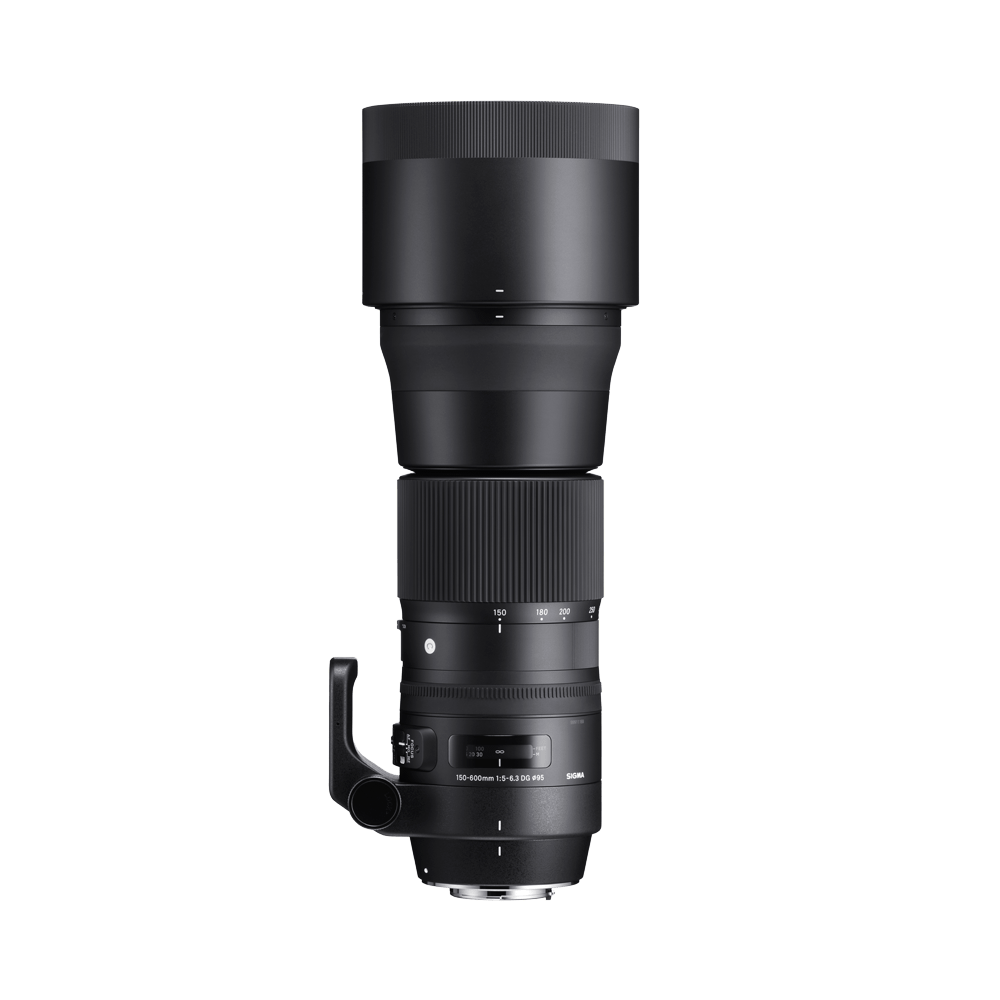
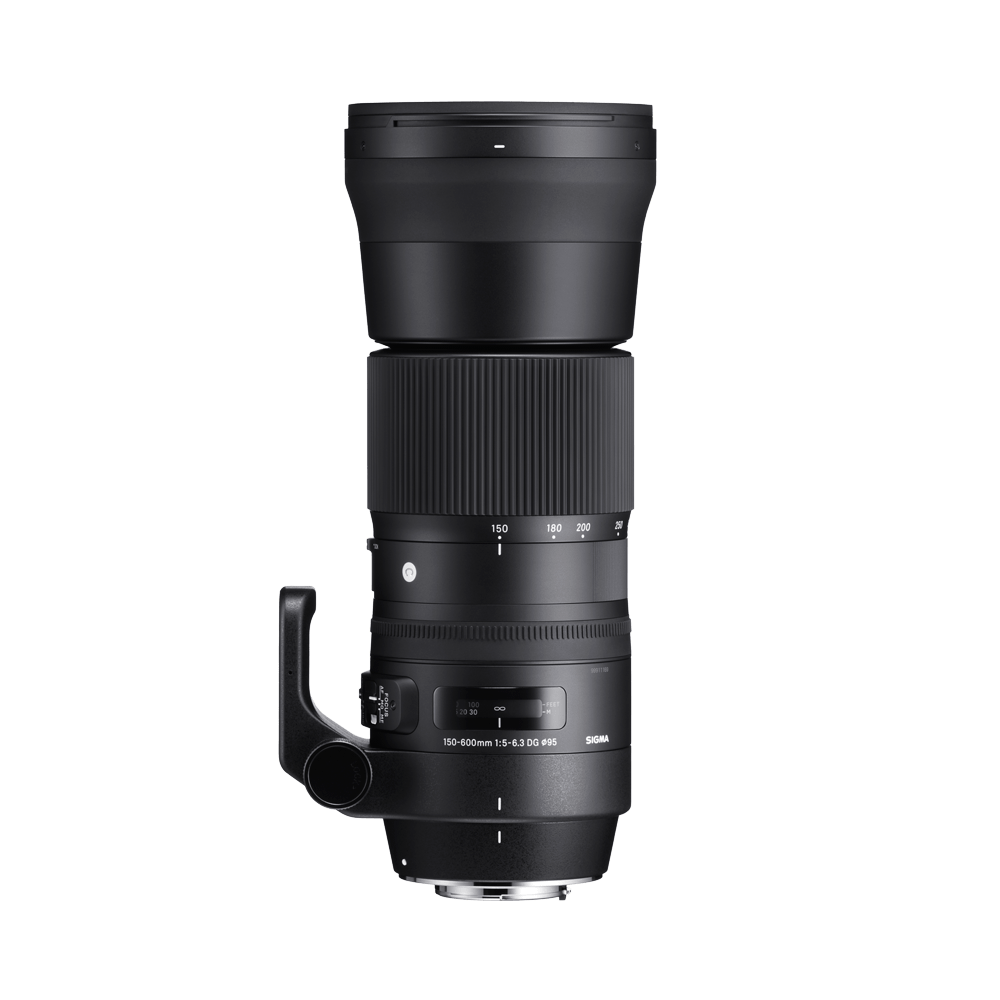
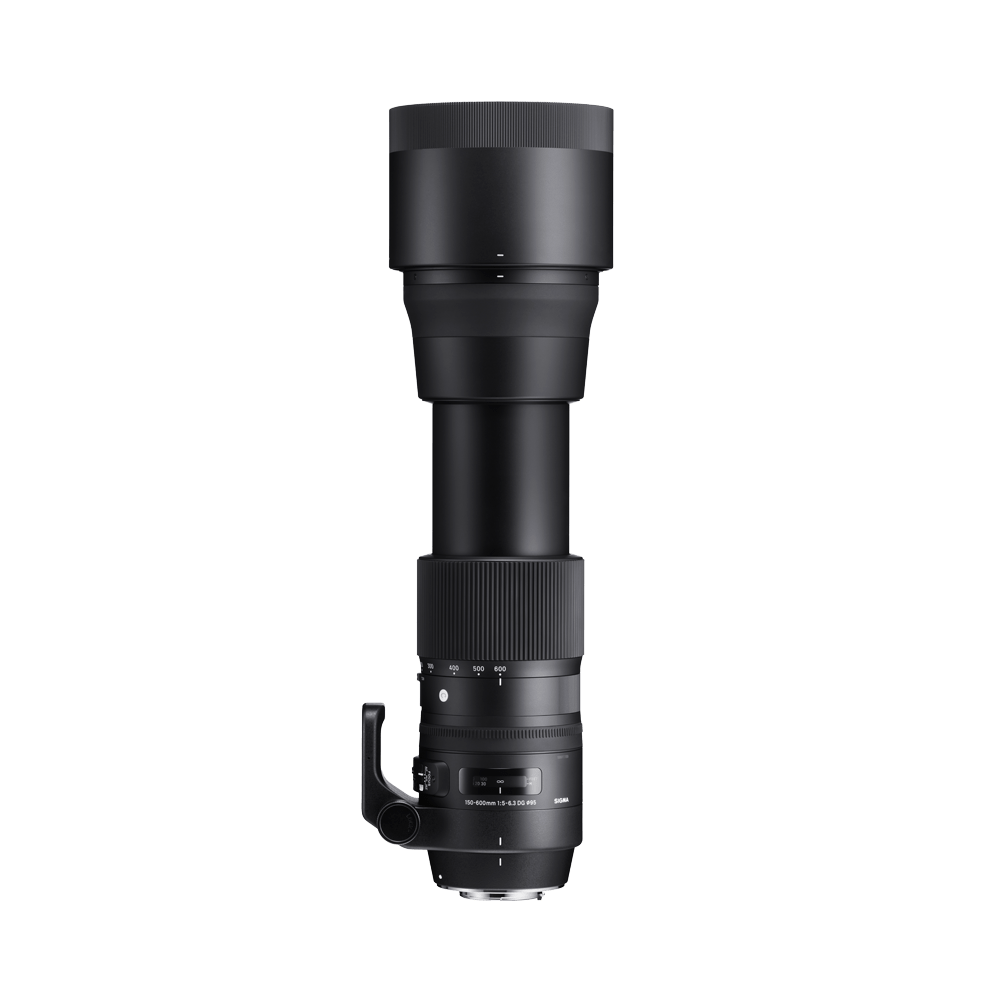
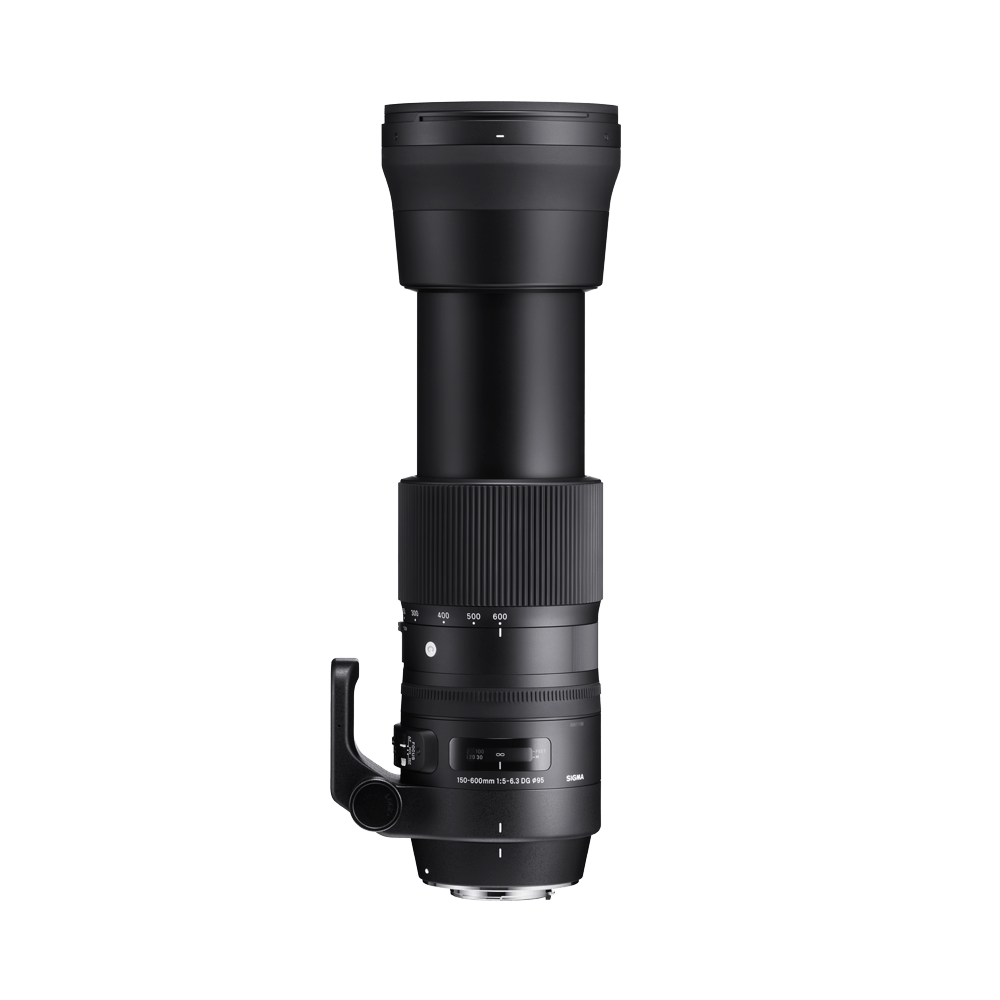
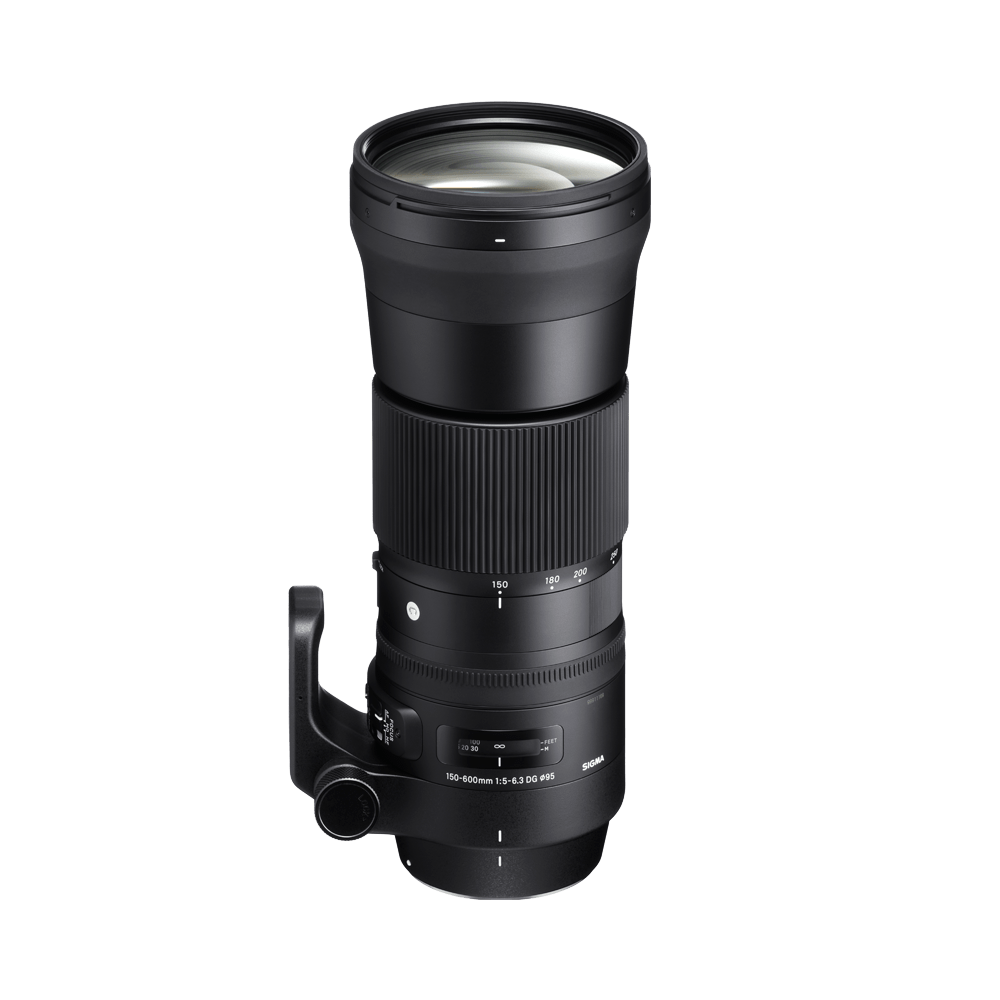





Contemporary
150-600mm F5-6.3 DG OS HSM
Available mounts
- Sigma SA-mount
- Canon EF mount
- Nikon F mount
-
Camera Type
DSLR
-
Corresponding Mount
SIGMA SA-mount, Canon EF mount, Nikon F mount
-
Sensor Format
Full-frame [DG]
-
Lens Construction
20 elements in 14 groups
-
Angle of View
16.4° - 4.1°
-
Number of Diaphragm Blades
9 (Rounded diaphragm)
-
Minimum Aperture
F22
-
Minimum Focusing Distance
280 cm / 110.2 in.
-
Maximum Magnification Ratio
1:4.9
-
Filter Size
φ95mm
-
Dimensions (Diameter × Length)
ø105mm × 260.1mm /ø4.1 in. × 10.2 in.
*The length of a lens is measured from the filter surface to its mount.
-
Weight
1,930 g (Protective cover : 1,830 g) / 68.1 oz. (Protective cover : 64.5 oz.)
-
Edition Number
C015
The three-digit code on the surface of the lens is to indicate the year the lens was first released.
(Since it is different from the year of manufacture, the release year and edition number may not match depending on the mount.) -
Supplied Accessories
・Case
・LENS HOOD LH1050-01
・FRONT CAP LCF-95mm III
・PROTECTIVE COVER PT-11
・REAR CAP LCR II
・TRIPOD SOCKET TS-71
・Shoulder Strap -
Mount / Product Barcode
SIGMA SA-mount:00-85126-74556-1
Nikon F mount:00-85126-74555-4
Canon EF mount:00-85126-74554-7
-
Camera Compatibility
LINK
-
* Values are for Sigma SA-mount
-
A robust specification offering both maneuverability and usability.
While lightweight, this model offers robust core functionality for use in a wide variety of photographic scenes.
The result is a super-telephoto lens with outstanding performance.This lightweight lens is easy to carry and use in a wide variety of photographic scenes. At the same time, as may be expected of a member of our high-performance Contemporary line, this lens features all the core functionality you need for your photography, including dust and splash resistant structure, a zoom lock switch that can be set for any focal length, a water- and oil-repellent lens coating, an easily accessible AF/MO/MF switch, and a newly designed tripod socket. This lens is also compatible with Sigma’s newly developed teleconverters (sold separately), with which it offers AF up to F8.
-
Water and oil-repellent coating helps ensure performance in all conditions.
The foremost lens elements feature a water- and oil-repellent coating that allows water to be wiped away easily and prevents oil and fat from sticking to the surface, even in challenging shooting conditions. This coating also makes maintenance of the lens surface easier.

Without coating

With coating
-
Mount with Dust and Splash Resistant Structure
As with the Sigma 150-600mm F5-6.3 DG OS HSM | Sports from the Sports line, the lens mount incorporates rubber sealing to protect the mount from dust and water drops.

-
Intelligent OS featuring updated algorithm.
The OS (Optical Stabilizer) function features an acceleration sensor to ensure even higher precision. Two OS modes are available: Mode 1 for general photography and Mode 2 for motor sports and other applications requiring panning. In Mode 2, the acceleration sensor teams up with the Intelligent OS and its updated stabilization algorithm to deliver effective stabilization while you move the camera horizontally, vertically, or diagonally—regardless of the position of the lens. This feature helps ensure effective panning and outstanding capture of moving subjects.

-
Two full-time manual modes available, including manual override.
In addition to AF and MF, MO (Manual Override) is available as an option via the focus mode switch. When the switch is set in the MO position, the lens may be switched to manual focus simply by rotating the focus ring—even during continuous AF. In the AF position, standard full-time manual focus remains available. With the Sigma USB DOCK (sold separately), you can easily customize the degree of twist sensitivity in MO mode.

-
Zoom lock switch that can be set at any focal length.
The new zoom lock switch enables the zoom ring to be locked at any focal length. It can be fixed at the photographer’s desired focal length, which allows stable shooting even when the lens is positioned upward or downward. This feature is also useful during long-exposure photography.

-
Quieter and faster optimized AF
The HSM (Hyper Sonic Motor) ensures high speed and quiet AF. Enhancing the drive algorithm applied in previous models, Sigma has enhanced focus accuracy in autofocus continuous (AF-C) mode by 5 percent.

-
High-precision, rugged brass bayonet mount
The brass mount combines high precision with rugged construction. Its treated surfaces and enhanced strength contribute to the exceptional durability of the lens.

-
TSC (Thermally Stable Composite)
Conventionally it is considered essential to leverage the qualities of metal and polycarbonate in camera and lens layout design. A first for the industry, the barrel of the new series of Sigma lenses features a new (*)TSC (Thermally Stable Composite) that offers minimal thermal shrinkage combined with exceptional hardness. Since its thermal shrinkage is low, TSC matches well with metal parts, further contributing to the high-precision construction of the lens.
(*)TSC (Thermally Stable Composite)
TSC (Thermally Stable Composite) is a type of polycarbonate with a thermal expansion rate similar to that of aluminum. It has high affinity to metal parts which contributes to high quality product manufacturing. -
Featuring enhanced usability, this lens offers the outstanding optical performance of Sigma’s Contemporary line.

-
Minimized transverse chromatic aberration—thanks to FLD and SLD glass lens elements.
This lens features one (*)FLD (“F” Low Dispersion) glass element, which offers performance equivalent to fluorite, and three SLD (Special Low Dispersion) glass elements to minimize chromatic aberration. In particular, the low-dispersion glass elements and optimized power distribution help minimize transverse chromatic aberration, which can tend to affect the telephoto end and cannot be reduced by adjusting focus. The end result is outstanding image quality throughout the zoom range.
(*)FLD ("F" Low Dispersion) glass
FLD glass is ultra-low-dispersion glass that offers performance of the highest level. Highly transparent, its refractive index and dispersion are extremely low as compared to conventional types of glass. It offers characteristics very similar to those of fluorite, which is valued for its anomalous dispersion. These characteristics minimize residual chromatic aberration (secondary spectrum), which cannot be corrected by ordinary optical glass, while helping to produce sharp, high-contrast images.
-
Flare and ghosting reduction
From an early stage in the lens design process, flare and ghosting have been measured to establish an optical design resistant to strong incident light sources such as backlighting. Sigma’s Super Multi-Layer Coating reduces flare and ghosting to help photographers produce sharp and high contrast images even in backlit conditions. The included lens hood can be attached to block out extraneous light, which can have a negative effect on rendering performance.

-
Exclusive low-dispersion glass
The degree to which light is refracted by glass depends on the light’s wavelength. This fact causes different colors of light to focus at slightly different points. The result is chromatic aberration, the color fringing that is particularly noticeable in telephoto lenses. Most chromatic aberration can be removed by combining a high-refractivity convex lens element with a low-refractivity concave element. Yet residual chromatic aberration known as “secondary spectrum” may still remain. To minimize this secondary spectrum, which can be a serious issue with conventional lenses, Sigma lenses feature up to three types of exclusive low-dispersion glass offering superior performance: ELD (Extraordinary Low Dispersion), SLD (Special Low Dispersion) and FLD (“F” Low Dispersion). In particular, FLD glass offers ultra-low dispersion in combination with high transmittance and the anomalous dispersion characteristics of fluorite. Meticulous deployment of these types of exclusive low-dispersion glass and optimization of power distribution gives Sigma lenses superlative image rendition undiminished by residual chromatic aberration.

-
Rounded diaphragm
When photographing with point light sources such as electric lights or reflections on a body of water in the background, the rounded 9-blade diaphragm helps produce an attractive bokeh effect—even at large-aperture settings.

-
Newly designed Teleconverters that enables AF to be effective up to F8
Teleconverters that are newly designed to match the new lens line-ups can be attached. The addition of Sigma’s TELECONVERTER TC-1401 or TELECONVERTER TC-2001 produces a MF 210-840mm F7-9 hyper-telephoto zoom lens or a MF 300-1200mm F10-12.6 hyper-telephoto zoom lens respectively. In addition, when Sigma TELECONVERTER TC-1401 is attached to cameras that are compatible with AF at F8, it is possible to shoot with AF.
*When shooting subjects with low contrast or luminosity value, focus may not be spot on the subject.

-
About Tele Converter
LINK
Lens construction

FLD glass
SLD glass
MTF Chart
The MTF (Modulation Transfer Function) is one of the measurements for evaluating a lens’ performance, and it shows how faithfully the contrast of the subject can be reproduced on the image plane. The horizontal axis shows the image height (distance from the center of the image in mm) and the vertical axis shows the contrast value (maximum value is 1).
The closer the 10 line pairs/mm curve is to 1, the higher the contrast and clarity of the lens is, and similarly, the closer the 30 line pairs/mm curve is to 1, the better the resolution and sharpness of the lens is.
*The MTF chart depicts the result at the wide-open aperture.
*For mirrorless lenses that support distortion correction, the horizontal axis shows the image height equivalent to when an L-Mount lens is attached to a Sigma L-Mount camera with distortion correction applied. (The effect of distortion correction may differ depending on the mount and camera used.)
*The spatial frequency indicates the variation on the image plane before distortion correction is performed.
-
Spatial frequency
S:Sagittal Line
M:Meridional Line
-
10lp/mm
-
30lp/mm
Diffraction MTF

Diffraction MTF

Geometrical MTF

Geometrical MTF

Distortion
effective distortion
When you take a picture of a lattice pattern, it will appear as the blue dotted line shows. The red line illustrates how the lattice pattern will appear in the actual picture when any lens distortion is taken into account.
relative distortion
In this chart, the horizontal axis shows the ideal image height (the distance from the center to the edge of the image [mm]). The vertical axis shows the extent of distortion. The extent of distortion is represented by how much Y, which is the actual image height, grows (or shrinks) against Y0 which is the ideal image height.
When you take the picture of a square object, if the distortion amount shows a minus value, the image will be seen as expanded (Barrel distortion). If the distortion amount is a plus value, it will be seen as a recessed (Pincushion distortion). When the distortion value is close to 0, the appearance of distortion is very minimal.




Vignetting
The horizontal axis shows the image height (the distance from the center to the edge of the image [mm]).The vertical axis shows the amount of light in the image (based on the amount of light in the image center being 100%). If the peripheral amount of light is lower than the center, the four corners of image will be darker (vignetting).
-
F5(150mm) - F6.3(600mm)
-
F11(150mm) - F11(600mm)
-
F22(150mm) - F22(600mm)


A lightweight hyper-telephoto
zoom lens featuring high usability
and outstanding optical performance.
The latest fine lensin our Contemporary line.
At just 1,830g, this lens is ideal for handheld photography.
Offering all the core features of our similar professional lens in the Sports line,
this lens boasts incredibly compact and lightweight construction.
The highly compact, lightweight version of the 150-600mm F5-6.3 DG OS HSM | Sports lens in our Sports line. When removed from the camera, this lens is easy to carry.
The tripod socket may be detached and replaced with a protective cover to further reduce weight and make handheld photography an even more lightweight and convenient experience. This lens is the optimal choice for photographers who desire super-telephoto functionality while staying light on their feet.
Exemplifying the outstanding performance of the Contemporary line, this lens offers the same high optical performance in a lightweight package ideal for a wide variety of photographic scenes.
Retaining the basic specifications of the Sigma 150-600mm F5-6.3 DG OS HSM | Sports in the Sports line, this lens offers lightweight and compact construction ideal for carrying and extended handheld photography. With an emphasis on optical performance, this lens features FLD (“F” Low Dispersion), SLD (Super Low Dispersion), and other fine glass elements and optimized power distribution. An issue for hyper-telephoto lenses in particular at the telephoto end, optical aberrations have been minimized throughout the zoom range. Mount with dust and splash resistant structure, to facilitate photography in the field, and featuring a detachable tripod socket for more convenient handheld photography, this lens is a lightweight high-performance model offering outstanding usability.
[Contemporary]
Leveraging the latest technology to combine outstanding optical performance with compact design, this line is perfect for a wide range of photographic scenes.
Sigma is organizing all its interchangeable lenses into three product lines; Contemporary, Art and Sports. Among the three, the Contemporary line is a high performance line which incorporates the very latest technology making it possible to accommodate both high optical performance and compactness for use in various photography situations. Sigma has solved the difficult problem of keeping the size and weight down without compromising optical performance and function with the latest technology.
Lens specifications
Detachable tripod socket.
The tripod socket is detachable, allowing the lens to be carried by itself. After the socket is replaced with the protective cover, the lens weighs only 1,830 g for easier carrying. Without the socket, the lens has minimal protruding parts and fits well into limited space for storage. Moreover, the tripod socket is made of magnesium, which is light and strong at the same time.
